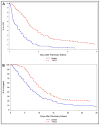Risk factors and outcomes in transfusion-associated circulatory overload
- PMID: 23357450
- PMCID: PMC3652681
- DOI: 10.1016/j.amjmed.2012.08.019
Risk factors and outcomes in transfusion-associated circulatory overload
Abstract
Background: Transfusion-associated circulatory overload is characterized by new respiratory distress and hydrostatic pulmonary edema within 6 hours after blood transfusion, but its risk factors and outcomes are poorly characterized.
Methods: Using a case control design, we enrolled 83 patients with severe transfusion-associated circulatory overload identified by active surveillance for hypoxemia and 163 transfused controls at the University of California, San Francisco (UCSF) and Mayo Clinic (Rochester, Minn) hospitals. Odds ratios (OR) and 95% confidence intervals (CI) were calculated using multivariable logistic regression, and survival and length of stay were analyzed using proportional hazard models.
Results: Transfusion-associated circulatory overload was associated with chronic renal failure (OR 27.0; 95% CI, 5.2-143), a past history of heart failure (OR 6.6; 95% CI, 2.1-21), hemorrhagic shock (OR 113; 95% CI, 14.1-903), number of blood products transfused (OR 1.11 per unit; 95% CI, 1.01-1.22), and fluid balance per hour (OR 9.4 per liter; 95% CI, 3.1-28). Patients with transfusion-associated circulatory overload had significantly increased in-hospital mortality (hazard ratio 3.20; 95% CI, 1.23-8.10) after controlling for Acute Physiology and Chronic Health Evaluation-II (APACHE-II) score, and longer hospital and intensive care unit lengths of stay.
Conclusions: The risk of transfusion-associated circulatory overload increases with the number of blood products administered and a positive fluid balance, and in patients with pre-existing heart failure and chronic renal failure. These data, if replicated, could be used to construct predictive algorithms for transfusion-associated circulatory overload, and subsequent modifications of transfusion practice might prevent morbidity and mortality associated with this complication.
Copyright © 2013. Published by Elsevier Inc.
Conflict of interest statement
Figures


References
-
- Popovsky MA. Pulmonary consequences of transfusion: TRALI and TACO. Transfus Apher Sci. 2006;34(3):243–244. - PubMed
-
- Popovsky MA, Audet AM, Andrzejewski C., Jr Transfusion-associated circulatory overload in orthopedic surgery patients: a multi-institutional study. Immunohematology. 1996;12(2):87–89. - PubMed
-
- Division of Healthcare Quality Promotion, National Center for Emerging and Zoonotic Infectious Diseases, Centers for Disease Control and Prevention (CDC) The National Healthcare Safety Network (NHSN) Manual, Biovigilance Component. Atlanta, GA: CDC; Jul, 2010.
-
- Skeate RC, Eastlund T. Distinguishing between transfusion related acute lung injury and transfusion associated circulatory overload. Curr Opin Hematol. 2007;14(6):682–687. - PubMed
Publication types
MeSH terms
Grants and funding
LinkOut - more resources
Full Text Sources
Other Literature Sources
Medical
Miscellaneous

